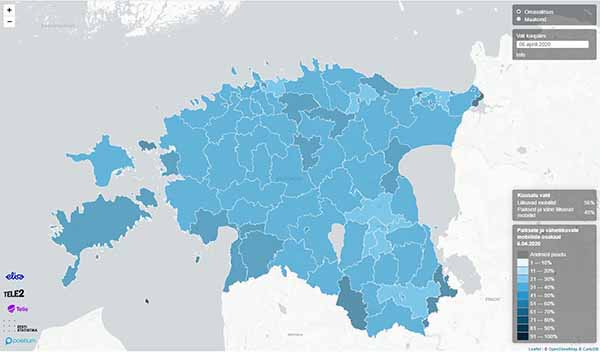Analytics, Covid-19, Crisis, Estonia, Medicine, Society
International Internet Magazine. Baltic States news & analytics
Thursday, 01.01.2026, 19:01
Statistics Estonia: people stay in one location 20 hours per day on average
 Print version
Print versionAccording to Director General Mart Mägi, Statistics Estonia analysed by order of the crisis commission whether people have stayed more local after the declaration of the emergency situation. “The mobility analysis showed that Estonian people stay 20 hours per day on average in their main location, their distance covered in one day has decreased from 27.5 kilometres to 17.6 kilometres, and their number of trips in one day away from the main location has decreased from 1.8 to 1.5,” said Mägi.
“New movement restrictions in public places were set at the end of March. The mobility analysis revealed that compared to the first weeks of the emergency situation when movement decreased, the additional restrictions have not had a clear impact on mobility,” added Mägi.

For the mobility analysis, Statistics Estonia used aggregate tables of the movement analysis of mobile phone numbers, which were received from mobile operators. These were used as the basis for calculating the rate for staying local for the whole country. Real-time data of clients were not used in the analysis. These were anonymous aggregate data. It is not possible to identify or analyse movement patterns of individual people on the basis of the anonymous data.
Four weeks ago, an emergency situation was declared in Estonia – schools and cultural institutions were closed and restrictions were placed on ferry trips. In the following weeks, new restrictions on movement have been added, including the closing of shopping centres. During the emergency situation, the mobility analysis carried out in cooperation between Statistics Estonia, mobile operators, the Government Office, the Health Board, the Data Protection Inspectorate, ministries, the IT Centre of the Ministry of Finance and Positium provides the crisis commission overviews of people’s mobility and serves as input for decisions on how to gradually lift the restrictions. Mobility analyses and their transfer will be continued until the end of the emergency situation.
Description of the mobility analysis method
Mobile operators are using a method developed in cooperation with Statistics Estonia, ensuring reliability of the mobility analysis.
The operators prepared separate mobility analyses of their clients, based on anonymous data from the mobile network starting from 20 February 2020. They identified the main location of each mobile phone number, for which they determined the mobile phone masts that the number was connected to the longest in a 24-hour period. Both average and maximum distance from the main location were taken into account. It is not possible to identify or analyse movement patterns of individual people on the basis of the anonymous historical data. The mobility analysis covers only Estonia and does not show which countries Estonian residents have been to or are at.
The results were generalised at the level of local municipalities and, when possible, at a more detailed level (e.g. by urban regions in Tallinn and Tartu). Statistics Estonia reviewed the aggregate data received from the mobile operators and calculated the rate for staying local, which was used for output such as “87% of the mobile phones in XXX area remain local”. Enterprise Positium visualised the mobility analysis results on the Estonian map.
The purpose of the mobility analysis ordered by the crisis commission of the Government of the Republic is to study how the Estonian society has adopted the measures introduced during the emergency situation, i.e. whether people have stayed more local. The anonymous data are not used to solve any other tasks. The data storage period for the data used in the mobility analysis lasts until the analysis purpose has been achieved and the emergency situation ends. After the end of the project, all data will be deleted.
- 30.12.2020 Hotels showing strong interest in providing self-isolation service
- 30.12.2020 EU to buy additional 100 mln doses of coronavirus vaccine
- 30.12.2020 ЕС закупит 100 млн. дополнительных доз вакцины Biontech и Pfizer
- 29.12.2020 В Латвии вводят комендантский час, ЧС продлена до 7 февраля
- 29.12.2020 Latvia to impose curfew, state of emergency to be extended until February 7
- 29.12.2020 Number of new companies registered in Estonia up in 2020
- 29.12.2020 В Риге можно изолироваться в трех гостиницах
- 28.12.2020 Рынок недвижимости Эстонии осенью начал быстро восстанавливаться
- 28.12.2020 Tartu to support students' solar car project
- 28.12.2020 First people in Latvia receive Covid-19 vaccines








 «The Baltic Course» Is Sold and Stays in Business!
«The Baltic Course» Is Sold and Stays in Business!

